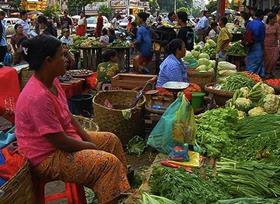
Regional manager of TNS Global, Ralf Matthaes, and managing director of Thai importer Vachamon, Wipavee Watcharakorn, have emphasised the wealth of opportunities for agriculture companies to expand their businesses in the Greater Mekong region.
Speaking at the 2013 Asiafruit Congress yesterday (3 September), Matthaes and Watcharakorn pointed to the 77m untapped consumers in Cambodia, Laos and Myanmar, 40 per cent of whom are under 20 years old.
“The region’s young population boom is a fantastic driver for consumerism,” Matthaes told delegates. “This bodes very well for the future.”
While these markets presently remain very small, Matthaes drew parallels between their size and that of Vietnam’s 15 years ago, which has since about quadrupled the size of its GDP.
Additionally, while much of the population of these countries is relatively poor, Matthaes pointed to their significant spending on groceries as an essential item.
“Many of these people are poor but they have no debt, as they actually own their own houses and cars unlike the developed world,” he explained. “So their disposable income is a lot higher than you’d think. On top of that, it is typical for people to spend around 40 per cent of their income on groceries.”
Furthermore, Matthaes pointed to some sections of Myanmar, which is currently being targeted by a variety of international businesses in the wake of recent reforms, as having profited from years of sanctions.
“11 per cent of the country has a monthly income of over US$750,” he said, “and a further 11 per cent earns US$500-750. In a country with 60m people, 22 per cent of these having the income to afford fresh produce is a very significant number.”
Watcharakorn pitched her native Thailand as the ideal hub from which other businesses could enter the region, highlighting its shared borders with Cambodia, Myanmar and Laos.
“From Bangkok, the closest Thai borders with Cambodia and Myanmar are only 255km and 400km away respectively,” she told delegates. “We also share a 1,700km border with Laos.”
Watcharakorn also spoke regarding the eventual aim of ASEAN, set to have 10 country members by 2015, to develop a single market, which will significantly advance business prospects in the region.
While the wealth of opportunities presents exciting times for the sector, Matthaes and Watcharakorn pointed to a variety of obstacles that entrepreneurs would have to be well aware of before endeavouring to conduct business in the region. These include poor infrastructure, regulatory issues, political instability, inefficient systems and unskilled workers.
“In Myanmar, 80 per cent of roads aren’t even paved,” Matthaes said. “So transport and logistics become very difficult. Also, the young population, while an advantage for driving consumerism, means that you would have to bring the training or imported labour to the country.”
“The customs borders present a real challenge for people doing business,” added Watcharakorn. “Workers might not be professional and ask for bribes given uncertainty over their job and its hours or pay. Systems procedures are also very inefficient.”
Both speakers also emphasised that company marketing approaches would have to be specifically tailored to the region they enter, particularly with modern trade formats comprising only a tiny percentage of fresh produce sales. “In Laos and Cambodia this would be only about 5 per cent, and in Myanmar only around 1 per cent,” said Matthaes, “so very different marketing campaigns would be required from those in developed countries.”



